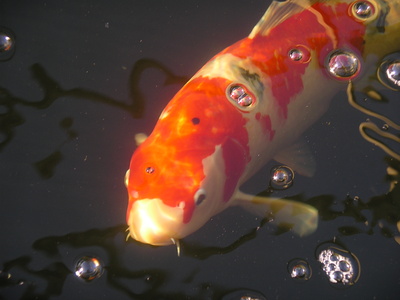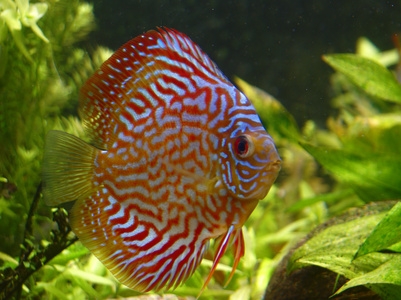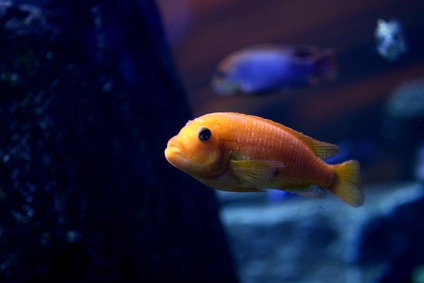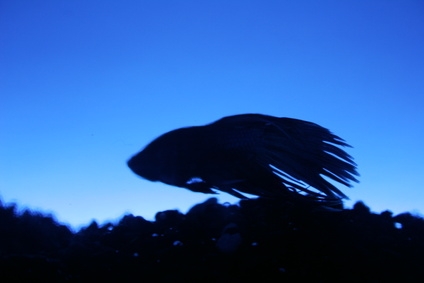
Now that you've thought through some of the preliminary issues involved in a successful breeding operation, it's time to talk about the physical setup. There are two basic scenarios: You can breed fish as a group in a single-species tank, or provide your breeding pair with a tank all to themselves. Each comes with built-in advantages and disadvantages; which one you choose will depend mostly on the needs of the species of fish you're trying to breed, but should also take into account what you're trying to accomplish with your breeding program, and the time and energy you have to put into it.
Breeding Tanks
The opposite of the community-tank approach, these are tanks designed to meet the spawning needs of particular fish. Fish are sometimes conditioned for breeding in a community tank, and then transferred to the breeding tank for spawning.
Pros: Because you only have to worry about the needs of one pair (or in some cases, a small group) of fish, you can cater to their spawning preferences, thereby maximizing your chances of breeding them successfully.
Cons: There can be a fair amount of both time and expense involved in setting up and maintaining a breeding tank; you'll need not only the tank (or tanks) but a hood, stand, heater, and filter, plus whatever specific pieces of equipment are required by the species you're trying to breed. And did we mention that you'll also need space for all of the above? You'll also have to net your breeding pairs to transfer them to the new tank, something that can be stressful for both fish and keeper.
Species Tanks
A cross between a community and a breeding setup, a species tank was the most common way of breeding fish in the early days of the hobby. In this setup, a same-species group of fish is kept in a single tank, and several generations of their offspring grow up and breed together. Such setups work well for livebearers, as well as species such as danios that prefer to spawn in groups. Some breeders who use species tanks divide them into zones, planting one area densely as a sort of "maternity" and fry-raising area, while leaving plenty of open swimming area for the other fish.
Pros: Like breeding tanks, species tanks enable you to control the environment-water, temperature, etc.-to meet the needs of the species you're trying to breed without worrying about whether those needs clash with other fish in the tank. It usually involves less work than a breeding setup, since you can leave the fish in their environment instead of creating an entirely new one just to spawn them. You'll be able to observe the emergence of social hierarchies as well as the mate-selection process.
Cons: Some of the drawbacks of the community tank apply. If you want a high yield of fry, you may have to remove the eggs (or the fry, in the case of livebearers) to prevent them from being eaten. And since the fish will pick their own mates, you won't be able to selectively mate them to enhance particular characteristics in their fry. Species tanks are also inappropriate for some aggressive fish, such as Oscars or bettas, since they generally are don't tolerate same-sex members of their own species.
 Causes of Pond Fish Sitting on the Bottom of the Pond and Refusing to Eat
Causes of Pond Fish Sitting on the Bottom of t
Causes of Pond Fish Sitting on the Bottom of the Pond and Refusing to Eat
Causes of Pond Fish Sitting on the Bottom of t
 How to Take Care of The Baby Betta Fish
How to Take Care of The Baby Betta Fish
How to Take Care of The Baby Betta Fish
How to Take Care of The Baby Betta Fish
 Discus Fish Care & Feeding
Discus Fish Care & Feeding
Discus
Discus Fish Care & Feeding
Discus Fish Care & Feeding
Discus
 How to Take Care of a Baby Parrot Fish
How to Take Care of a Baby Parrot Fish
How to Take Care of a Baby Parrot Fish
How to Take Care of a Baby Parrot Fish
 How to Tell a Male Betta From a Female Betta
How to Tell a Male Betta From a Female Betta
How to Tell a Male Betta From a Female Betta
How to Tell a Male Betta From a Female Betta
Copyright © 2005-2016 Pet Information All Rights Reserved
Contact us: www162date@outlook.com